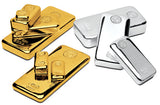Jewellery Glossary Terms
Akoya Pearls:
 Pearls from the Akoya saltwater oyster which is the mainstay of the Japanese pearl industry. Now also farmed by China and other countries.
Pearls from the Akoya saltwater oyster which is the mainstay of the Japanese pearl industry. Now also farmed by China and other countries.
Alloy:
 An alloy is a combination of two or more metals. Common alloys used in jewellery and giftware in the UK & Ireland are: Gold 9ct (37.5% gold with varying amounts of other metals such as silver depending on colour and other characteristics wanted) Gold 18ct (75% gold), 22ct (91.6% and very soft); Platinum (95% platinum); Silver Sterling (92.5% silver); and Pewter (92% tin with lead, antimony and a bit of silver or copper).
An alloy is a combination of two or more metals. Common alloys used in jewellery and giftware in the UK & Ireland are: Gold 9ct (37.5% gold with varying amounts of other metals such as silver depending on colour and other characteristics wanted) Gold 18ct (75% gold), 22ct (91.6% and very soft); Platinum (95% platinum); Silver Sterling (92.5% silver); and Pewter (92% tin with lead, antimony and a bit of silver or copper).
Baroque Pearls:
 Irregular shaped pearls of all shapes and sizes, neither round nor symmetrical. The surface is usually uneven. Most are inexpensive, but some have come to be the centrepiece for very expensive pieces of jewellery.
Irregular shaped pearls of all shapes and sizes, neither round nor symmetrical. The surface is usually uneven. Most are inexpensive, but some have come to be the centrepiece for very expensive pieces of jewellery.
Biwa Pearls:
 Cultured freshwater pearls grown in Lake Biwa in Japan.
Cultured freshwater pearls grown in Lake Biwa in Japan.
Cabochon:
 A stone cut with a domed top and a flat bottom. These are usually round or oval.
A stone cut with a domed top and a flat bottom. These are usually round or oval.
Carat:

